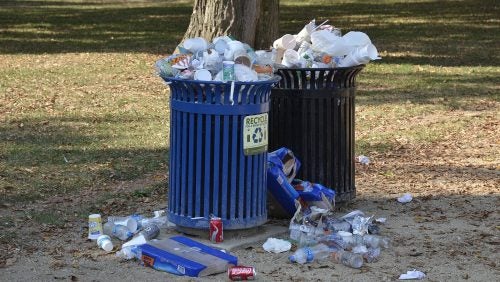D.C.’s Broken Glass
February 15, 2024 by Nicholas Merrill

Waste Bins Overflowing on the National Mall
Washington D.C. faces a crisis of confidence regarding its glass recycling practices. Does the District actually recycle our bottles? What can be done?
Working for many years in the District’s restaurant industry, I encountered two attitudes towards recycling. First, there were the zealots, shuddering at the sight of an empty wine bottle in a brown bin, eager to harangue the guilty party with a litany about the dangers of profligate waste. Then, there were the nihilists, tossing empties into the closest bin whether blue or brown. If confronted, they’d tell you that it doesn’t matter, that D.C. doesn’t recycle its glass anyway—all those bright blue bins emblazoned with the mobius loop? Merely a placebo to calm the environmentally conscious. But apathy in the face of government inaction will only create a self-fulfilling prophecy.
In 2013, the District launched Zero Waste DC, with the goal of 80% waste diversion by 2032.[1] After ten years, the District hasn’t come anywhere close to hitting its mark. As of 2022, the District recycled on 16% of its waste, and only 13% of its waste from apartment buildings.[2] While China’s 2018 decision to stop importing American waste has created a national recycling crisis,[3] the District’s local practices still need improvement.
Glass itself is rarely recycled.[4] While largely delegating recycling policy to the Mayor, D.C. law fails to impose minimal glass recycling standards. The Zero Waste Omnibus Amendment Act of 2020 required the Mayor to “establish a collection point in the District for waste collectors to bring source-separated glass for transfer to a glass recycling facility.”[5] Glass is deposited at one of two transfer stations before going to a material recovery facility (MRF).[6] According to Zero Waste DC, glass goes unrecycled for three reasons: (1) contamination, (2) holdups at transfer stations, and (3), shutdowns at the MRF.[7] The glass that actually is recycled is primarily used to cover landfills,[8] helping to reduce emissions and control disease vectors.[9] However, the Northeast Recycling Council, a nonprofit that seeks to minimize waste and improve recycling practices,[10] claims that daily cover is the least environmentally beneficial reuse of recycled glass.[11]
Single-stream recycling is primarily responsible for the District’s failure to use recycled glass for anything other than regional cover.[12] Single-stream recycling is a familiar system wherein all recyclable materials go to one place.[13] While convenient, this system degrades the quality of the glass and creates a higher likelihood of contamination.[14] Further, an effective single-stream system depends on MRFs that can effectively sort materials.[15] While single-stream systems became popular as MRFs grew more sophisticated, the District shows that not every jurisdiction is a good fit.
One solution to D.C.’s recycling problem is multi-stream recycling. In a multi-stream system, residents and businesses sort by material—preserving the glass and allowing for direct transfer to cullet processors.[16] Though most municipalities employ single-stream systems, states and municipalities have found increased efficiencies from switching to a multi-stream system.[17] The issue is that multi-stream recycling is perceived by some as more complicated and likely to result in confusion.[18] However, states and municipalities can combat this through effective education.[19] Further, such a change would signal to residents that the government cares about making a change. After all, if the government is seen as apathetic, residents are likely to respond in turn.
Another possible solution is a bottle deposit system. Bottle deposit encourages residents to take recycling into their own hands by charging a small fee at purchase—typically .05$—and refunding when they return bottles to a dedicated facility.[20] Bottle deposit has the added benefit of reducing litter and pollution by attaching value to what would otherwise be worthless.[21] But bottle deposit has issues of its own. In the 1980s, an effort to create a deposit system resulted in resistance from those who argued that such a system would “impose undue hardship on owners of small stores with limited storage space, as well as on elderly residents who would find it difficult to afford the nickel surcharge or return heavy bottles to stores.”[22]
Clearly, the District’s recycling procedures need an overhaul. Success depends not only on government action to improve efficiency and reduce waste, but also on resident engagement and a collective effort to curb apathy. It’s a feedback loop—if people don’t trust the District to recycle their waste, then they won’t bother to learn best practices.
[1] Zero Waste DC Plan, Zero Waste DC, https://zerowaste.dc.gov/zwdcplan (last visited Feb. 11, 2024).
[2] Mark R. Smith, DC’s Recycling Woes: What’s Next?, HillRag (Aug. 1, 2022), https://www.hillrag.com/2022/08/01/dcs-recycling-woes-whats-next/.
[3] Kimiko de Freytas-Tamura, Plastics Pile Up as China Refuses to Take the West’s Recycling, The New York Times (Jan. 11, 2018), https://www.nytimes.com/2018/01/11/world/china-recyclables-ban.html.
[4] Mark R. Smith, Recycling: From Blue Bins to Uncertainty, HillRag (Mar. 7, 2022), https://www.hillrag.com/2022/03/07/recycling-from-blue-bins-to-uncertainty/.
[5] D.C. Code Ann. § 8-1031.03b (West 2021).
[6] State of Recycling in the District, Zero Waste DC, https://zerowaste.dc.gov/page/state-recycling-district (last visited Feb. 11, 2024).
[7] Id.
[8] Id.
[9] What is an Alternative Daily Cover?, Western Environmental Liner (Mar. 20, 2018), https://westernliner.com/blog/what-is-an-alternative-daily-cover/.
[10] About NERC, Northeast Recycling Council, https://nerc.org/about-nerc/overview (last visited Feb. 12, 2024).
[11] Press Release, Northeast Recycling Council, MRF Glass Used as Alternative Daily Cover (July 12, 2023), https://nerc.org/news-and-updates/press-releases/?article=2480.
[12] Zero Waste DC, supra note 6.
[13] Veronique Lacapra, With ‘Single-Stream’ Recycling, Convenience Comes At A Cost, NPR (Mar. 31, 2015), https://www.npr.org/2015/03/31/396319000/with-single-stream-recycling-convenience-comes-at-a-cost.
[14] Id.
[15] Zero Waste DC, supra note 6.
[16] Mitch Jacoby, Why glass recycling in the US is broken, Chemical & Engineering News (Feb. 11, 2019), https://cen.acs.org/materials/inorganic-chemistry/glass-recycling-US-broken/97/i6.
[17] Jacob Wallce, Dual-stream recycling proponents feel vindicated after converted communities see financial benefits, Waste Dive (Dec. 15, 2021), https://www.wastedive.com/news/dual-stream-recycling-wilkes-barre-lake-worth-beach/611493/.
[18] Id.
[19] See, e.g., Collection Systems, Standardized Container Colors, and Labeling, CalRecycle, https://calrecycle.ca.gov/organics/slcp/collection/systems/ (last visited Feb. 11, 2024).
[20] Justin Wm. Moyer, First they tackled plastic bags. Now they’re taking aim at bottles., The Washinton Post (Jan. 15, 2024), https://www.washingtonpost.com/dc-md-va/2024/01/15/waterway-plastic-bottle-cleanup/.
[21] Id.
[22] Gwen Ifill, BOTTLE FEUD TAPS CHURCHES, The Washington Post (July 5, 1987), https://www.washingtonpost.com/archive/local/1987/07/06/bottle-feud-taps-churches/9be0835f-dbd9-4258-8bd6-0de98b90e940/.

